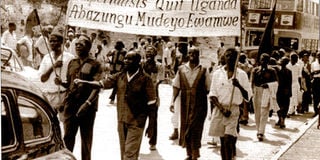Behind the struggle for Uganda’s independence

Ignatius Musaazi and Kununka (3R) stir up Ugandans to demand self-rule from Britain in Kampala in the mid-1950s. FILE PHOTO
What you need to know:
- Politics. Uganda’s first political party the Uganda National Congress (UNC) was founded in 1952.
- Sir Frederick Mutesa, the first none executive president of Uganda who was also a monarch, found it difficult to take orders from the national government, which was headed by Milton Obote.
The origin of the struggle for Uganda’s Independence began in 1940s when Ugandans staged various demonstrations against the colonial rule largely objecting to economic exploitations.
They objected the manipulative pricing of their cash crops that did not give the deserved benefits. Such bold and courageous face-up against the colonial rule later metamorphosed political agitation leading to the formation of various political parties all agitating for self-rule.
As a result, Uganda’s first political party the Uganda National Congress (UNC) was founded in 1952. The party that was largely for farmers was founded by Ignatius Kangave Musaazi, Abubakar Kakyama Mayanja, Stefano Abwangoto (Bugisu), Ben Okwerede (Teso), Yekosofati Engur (Lango), and S.B. Katembo (Tooro).
Musaazi was the founding president general, and Mayanja was the founding secretary general. Others were chairpersons in their respective regions. The party was first based at the Kabaka’s Lake, Mengo, in the house of Kitamirike. His place was the headquarters of the party for several years before it moved to Katwe and later to Kololo in the late 1950s.
The struggle for independence got a momentum with the formation of many other political parties that further enhanced the agitation for independence. Key among such parties was Uganda People’s Congress (UPC) of Dr Apolo Milton Obote, Grace Ibingira, John Kakonge and others. There was also the Democratic Party under Benedicto Kiwanuka plus other small political parties.
Sir Frederick Mutesa, the first none executive president of Uganda who was also a monarch, found it difficult to take orders from the national government, which was headed by Milton Obote.
In 1964, there was a referendum to decide whether two counties, which Buganda had annexed, should be returned to the neighbouring territory of Bunyoro. Bunyoro won, but Mutesa refused to sign the transfer instrument, thereby creating a crisis for the government.
From that point, matters deteriorated rapidly. Until 1966 Uganda managed to maintain a degree of stability, but in that year matters came to a head, as the Buganda government resolved to expel the Ugandan government from its soil (Ibingira, 1980).
Additional information from Uganda Media Centre website
This event played into the hands of Obote, whose national government responded by sending soldiers to the Kabaka’s palace to ‘investigate’ the presence of arms.
The soldiers (headed by Idi Amin) over-ran the palace and forced the Kabaka into exile. Obote proceeded to suspend the constitution crafted for the independence of Uganda and declared him-self executive president, head of state and government and commander-in-chief of the armed forces.
The political instability had begun which resulted into a coup by Idi Amin and total collapse of the state of Uganda.



